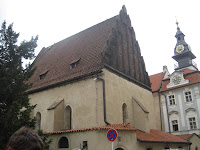Jan Hus has had a huge impact of the shaping of Prague into what it is today. His two major contributions were to the language and to religion.
Jan Hus, known to us better as John Hus, lived from 1300 to 1415. He was born in Bohemia but moved to Prague to study and later became the leader of the national Czech party. He became a preacher and went on to influence the writings of John Wycliffe. Both Hus and Wycliffe questioned and attacked doctrines of the Catholic Church. They believed in predestination and disagreed with the power given to the hierarchy of the church.
Another one of John Hus’s major complaints against the Church centered around the issue of language. He strongly believed Catholic mass should be given in the local language, or vernacular. He preached in both the Bohemian language and in Czech. He also translated Wycliffe’s work into Czech.
Today, the predominate language of Prague remains Czech. According to NationMaster.com, the percentage Czech is spoken by 94.9% of the country with Slovak being second most popular at 2%. Czech is a Western Slavonic language. Jan Hus greatly influenced the Czech language because he was the one who introduced a series of diacritical marks that change pronunciation and distinguish it from other Western Slavonic languages. One of his greatest contributions to the language was the establishment of the háček into Czech spelling which represents each sound by a single symbol.
It is surprising to me that the Czech language dominates today after learning that is was suppressed for centuries. From 1620 to 1918 the Habsburgs had control over Czech land and forbid the use of the language. This reminds me of the similar situation with Spain. Dictator Franco suppressed and forbade the use of Catalan language. In both cases, the forbidden languages not only survived, but thrived!
English is rapidly becoming the second language and after spending time in Prague, I would agree with this statement. Everywhere I went, whether it was a souvenir shop or clothing store popular among locals, almost everyone I encountered spoke some English.
Hus’ contribution to the Czech language is less well known than his contribution to the evolution of religion. John Hus continued to preach against the Catholic Church, even in 1410, when the Pope banned the writings and ideas of Wycliffe. Huss and his ideas gained many followers, which came to be known as the Hussites. Many Hussites were attacked and even forced to leave the country. John Hus openly attacked the Pope’s sale of indulgences, which caused the Pope to place the city of Prague under a papal interdict. All churches closed and church related activities were banned.
In 1414, Hus was called to the Constance Church Council to be a part of the ending of The
Great Schism. Instead, he was imprisoned and tried as a heretic and sentenced to death by burning at the stake. Hus’ death was significant, but not as much as the legend he left behind.
Today, walking around the city of Prague, it is evident the impact Hus made of religion. There are several churches in Prague that were part of the reformation movement led by Hus. The Bethlehem Church has special significance as it, according to our tour guide,

is the first Protestant church. John Hus preached here and this where most of the reformative movement took place. There came a point, however, when the Catholicism won popularity in the Czech Kingdom and converted this church into a Catholic one.
After my visit to Prague, it is apparent that John Hus is revered. Understandably so, with his great contributions to religion and the Czech language. There is a huge John Hus monument in the Old Town square. “It shows two groups of people, a young mother symbolizing national rebirth” (http://www.prague.cz/prague-old-town.asp) and victorious Hussites and Protestants who were forced into exile. I find it interesting that this large monument was built entirely by donations in the 1900’s. Monuments are very symbolic and representative, and in this case, it is telling that the monument was not erected by the government or large organization, but by everyday citizens who hold John Hus with high esteem.
Another thing I find interesting is that there is a public holiday devoted to Jan Hus in the Czech Republic on July 6, the anniversary of his death. This, despite the fact that the majority of Czechs describe themselves as non-religious and Catholicism is the dominant Christian religion. I find this ironic since Hus’ ideas stirred such controversy and even war, but today non-Protestants country takes a national holiday in honor of him. This speaks well of the country that move on from such differences in such a respectable way.















 For more information on the Fifa World Cup, see link below with schedules, scores and other history on this crazy phenomena.
For more information on the Fifa World Cup, see link below with schedules, scores and other history on this crazy phenomena.  (Map of Old Town Square)
(Map of Old Town Square)






 Flying into Prague adjacent to the Vltava River, more and more sights I had read about before journeying to the golden city became clearer.
Flying into Prague adjacent to the Vltava River, more and more sights I had read about before journeying to the golden city became clearer.
 As my sporadic thoughts about the city and walk across the bridge came to a close simultaneously, I felt slightly overwhelmed by my experience to that point in Prague.
As my sporadic thoughts about the city and walk across the bridge came to a close simultaneously, I felt slightly overwhelmed by my experience to that point in Prague.






